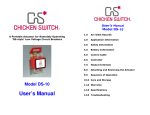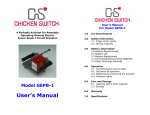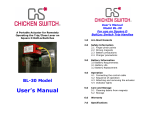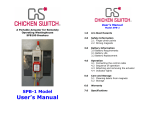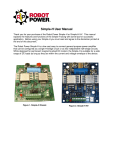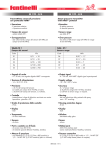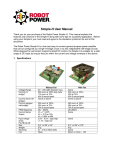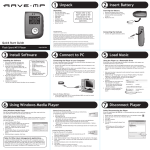Download User`s Manual - Chicken Switch
Transcript
User’s Manual Model SE-06 A Portable Actuator for Remotely Operating Square D Type SE Low Voltage Circuit Breakers 1.0 Arc-blast Hazards 2.0 Application Information 3.0 Safety Information 4.0 Battery Information 5.0 Control Cable 6.0 Controller 7.0 Underside Illuminator 8.0 Attaching and Removing the Actuator 9.0 Sequence of Operation 10.0 Care and Storage Model SE-06 User’s Manual 11.0 Warranty 12.0 Specifications 13.0 Troubleshooting 1.0 Arc-blast Hazards The hazards associated with electrical arc-blasts are well documented. Studies conducted by numerous industries and professional organizations have sought to quantify the intensity of arc-blast, the risks to personnel, and various methodologies for mitigating the risks. Without doubt, increasing the distance between the arc and a human is the single greatest favorable factor in reducing injuries. The Chicken Switch® is not a panacea but rather one more tool available for protecting workers while they are performing electrical switching. Using a Chicken Switch® may not negate the need for additional personal protective measures. The user is ultimately responsible for evaluating each situation to determine if additional protective measures are needed. WARNING Electrical switching may present risk of serious injury or death. This device should only be used by qualified persons after careful analysis of the hazards. 2.0 Application Information The SE06 is suitable for Square D ‘SE’ non-racking circuit breakers that do not have a permanently mounted lockout device on the “OPEN” button. It is imperative that the face plate of the SE breaker is in good condition. The portion of the breaker faceplate that is contacted by the SE06 and surrounding enclosure must be free of dirt and obstructions such as laminated labels or other nonOEM objects. 3.0 Safety Information 4.2 ALWAYS connect the control cable to the actuator and controller BEFORE installing the Chicken • Switch®. • 3.1 Finger pinch points Use caution when attaching the Chicken Switch® to the breaker or while placing it near a ferrous surface. 4.3 3.2 Battery Life A set of fresh alkaline cells should yield hundreds of operations. The Chicken Switch® is designed as a portable device. It is not designed to remain with the control unit connected to the actuator for extended periods of time. To do so will deplete a fresh set of batteries in approximately four to five days. Battery Replacement • ALWAYS disconnect the control cable before replacing batteries to avoid possible static damage of the electronics! • Turn the control station upside down, remove the endplate retaining knob. Remove the endplate and slide the cover out as shown. CAUTION: Strong magnets Keep fingers clear of the bottom of the actuator when the actuator is near a ferrous surface. The holding magnets are very strong. Avoid placing the Chicken Switch® near electromechanical protective relays. 4.0 Battery Information 4.1 Battery Requirements • • Sixteen (16) AA alkaline cells are required – eight cells in each battery holder. Carefully observe polarity when installing cells. Rechargeable NiMh or NiCd batteries can be used. 5.0 Control Cable 5.1 Connecting the control cable 4.3a To connect/disconnect batteries Squeeze and push/pull 1. Align the arrow on the cable end with the top of the receptacle. 4.3b CAUTION: Static Discharge Potential • 4.3c • 2. Push in and engage the threads on the coupling nut and turn clockwise. To avoid possible damage to electronic components disconnect the control cable before replacing batteries. 3. After one or two turns of the coupling nut, push in on the cable end. Repeat this until the connector is fully seated. Installing Batteries 4. Use a similar technique of turn-stop-and-pull to disengage the cable ends. When installing batteries, push the batteries toward the positive terminal to ensure the top of the battery firmly contacts the battery holder terminal. NOTE: When the actuator is connected to the control station, the actuator will automatically drive to the neutral position if it is not already in this position (i.e., neither the ‘trip’ nor ‘close’ function will be activated). + + 6.1 6.0 The indicator lights & controls The Controller NOTE: the indicator lights only work when the ENABLE button is depressed. GREEN: indicates the actuator is being commanded to depress the TRIP button. RED: indicates the actuator is being commanded to depress the CLOSE button. YELLOW: indicates that both actuators are in the neutral position and the controller and batteries are healthy. Rapidly blinking YELLOW indicates the battery voltage with zero load has fallen to an unacceptable level. Operation is inhibited until batteries with an acceptable voltage level are installed. The ENABLE button: The Enable button must be continuously depressed in order to command the actuator. Releasing the Enable button has the same affect as returning the selector switch to neutral – the actuator moves to neutral. The Control Switch: The controller is designed for two-hand operation for the purpose of preventing inadvertent operation of the actuator. See the following section for a detailed description of the controller indicators and switches. The control switch is used to activate the Chicken Switch actuator to Trip or Close the breaker. The Control Switch is spring return to center. Turning the switch clockwise will close the breaker, counter-clockwise will trip the breaker. If the Control Switch is held in the trip or close position for longer than approximately 3 seconds the drive motor will de-energize and the actuator will remain in the driven position. When the Control Switch or the Enable button is released, the motor will energize to drive the actuator to the neutral position. 7.0 Underside Illuminator An LED light assembly is permanently installed on the underside of the Chicken Switch® actuator. This light can be used to assist with aligning and attaching the actuator in low light conditions. It also allows the user to more easily see the breaker contact position indicator when the actuator is on the breaker. 8.0 Attaching and Removing the Actuator 8.1 Pre-use Checks: BEFORE attaching the actuator, ensure the CLOSE plunger is fully retracted: The LED light is powered from the same batteries that the Chicken Switch® uses for operating the actuator. The LED light is lit anytime the control cable is connected. The current draw is minimal and the intent is to make the Chicken Switch® as easy to use for the operator as possible. With this design, the operator does not have to worry about turning the light on or having separate batteries for the light. …and the TRIP arm is in the full ‘up’ position. 8.2 To Attach the Actuator Using the black handles hold the Chicken Switch® at a slight angle and align the top angle of the Chicken Switch® on the ledge immediately below the trip unit. Lift the red magnet lever (lower right corner) to the full up position to engage the bottom holding magnet. UP to attach DOWN to release The actuator should look like this when it is properly positioned: Rotate the bottom of the Chicken Switch® downward toward the breaker until it is held flush against the face of the circuit breaker by the holding magnets. Window for viewing the breaker status (open or closed) flag. 9.0 8.3 To Remove the Actuator Sequence of Operation: Steps 1. Connect the control cable to the Actuator first. Then connect the other end to the Control Station. Note that the actuators will move to the neutral position if they are not already in the neutral position. Rotate the red magnet lever to the ‘full down’ position in order to release the bottom holding magnet. See Section for more info 5.0 2. Visually verify that the CLOSE plunger is fully retracted (flush with the aluminum barrel), and the TRIP arm is in the ‘full up’ position. 8.1 3. Push the ENABLE button. Verify the YELLOW indicator light is lit steady verifying the actuators are in the neutral position and the batteries are good. 6.1 4. Attach the actuator to the breaker. 8.2 5. If the intended action is to close the circuit breaker, charge the breaker by operating the spring charging handle the required number of strokes. Verify the “Charged” flag is visible on the breaker “Closing Springs” indicator. Grasp both handles and rotate the SE06 upward as shown to disengage the top magnets. Lift the unit clear of the breaker. 6. Ensure you are at a safe distance from the circuit breaker that is to be operated. Note: The user must determine the safe distance based on NFPA 70E requirements. 7. When ready to operate the breaker, press and hold the ENABLE button. 6.1 8. The yellow light should illuminate whenever the ENABLE button is depressed, indicating the battery voltage is acceptable and the actuator is in the neutral position. 6.1 9. While holding the ENABLE button, operate the Control Switch on the Control Station in the appropriate direction for the desired action – trip or close. 6.1 10. Release the ENABLE button and control switch after the breaker has operated. 11. Remove the actuator from the breaker. 6.1 8.3 10.0 Care and Storage 10.1 Cleaning the magnets Over a period time, the magnets may attract ferrous debris. Exercise care to avoid setting the actuator where the magnets might attract debris. If this does occur, use a paper towel or nylon bristle brush to clean the face of the magnets. Masking tape can also be used to remove small dirt particles from magnets. Keeping the magnet faces clean ensures that maximum holding power is maintained. 10.2 Storage • Remove all batteries from the control station if the device will be not be used for longer than 6 months. • Never store the batteries where the ambient temperature might exceed 110º F. • Avoid getting the unit wet or storing it in a high humidity location. Store in a dry location. • Store the unit in its carrying case. 11.0 Warranty MarTek Ltd. guarantees all products manufactured by MarTek Ltd. only against defects in materials and/or workmanship for a period of twelve (12) months commencing on the date the product is received by the customer. THIS WARRANTY IS IN LIEU OF ALL OTHER EXPRESS OR IMPLIED WARRANTIES INCLUDING THOSE OF MERCHANTABILITY AND FITNESS FOR A PARTICULAR PURPOSE. MarTek Ltd. will, at its option and its cost (including shipping expenses for return and re-delivery), repair, replace or refund the purchase price of any product manufactured by MarTek Ltd. which has a defect in materials and/or workmanship. THIS IS CUSTOMER’S EXCLUSIVE REMEDY FOR BREACH OF WARRANTY. IN NO EVENT WILL MARTEK LTD’S LIABILITY FOR DAMAGES (WHETHER ARISING FROM BREACH OF CONTRACT OR WARRANTY, NEGLIGENCE, STRICT LIABILITY OR OTHERWISE) EXCEED THE PURCHASE PRICE OF THE PRODUCT CONCERNED NOR WILL MARTEK LTD. BE LIABLE FOR PUNITIVE, INCIDENTAL, CONSEQUENTIAL OR SPECIAL DAMAGES (INCLUDING WITHOUT LIMITATION LOST PROFITS) EVEN IF ADVISED OF THE POSSIBILITY OF SUCH DAMAGES. MarTek Ltd. reserves the right to disallow warranty repairs if the unit has been disassembled or misused, as determined by MarTek Ltd. in good faith. Please contact us at (800)-2484958 for a return authorization. MarTek Ltd. 4806 Chimney Drive Charleston, WV 25302 1-304-965-9220 1-800 248-4958 12.0 13.0 Troubleshooting Guide Specifications MECHANICAL Holding magnets: Three neodymium rare earth magnets rated @ 55.1 lbs force each. Gearmotor: All metal gears, in a formed metallic housing. DC brushed, permanent magnet motor with .375 inch diameter shaft (9.5 mm). Projected life: 20,000 operations ELECTRICAL Operating voltage: 24 volts DC Fuse: 5 amp, quick-blow, AGC-5 Power supply: 16 AA alkaline disposable batteries. When used properly, one set of batteries should yield over 500 operations. Control Cable: 30 feet in length (9.1 meters), 5-conductor, extra-flexible, PUR insulation. Optional 50’ cable. Controller: Requires two-hand operation. The ‘enable’ button must be depressed while rotating the controller selector switch. A programmable micro-controller manages control inputs, motor functions, monitors and limits mechanical travel and performs timing functions to protect the motor in a stalled condition. An intelligent ‘H-bridge’ motor driver provides start/stop/braking motor functions. The Hbridge has integral thermal shutdown protection. 1. The Chicken Switch will not operate. The yellow LED flashes rapidly whenever the Enable Button is depressed. • This is caused by a ‘low voltage lockout’. Replace the batteries. 2. Yellow light does not light when depressing ENABLE button, the RED and GREEN lights work when operating control switch, but the actuator does not operate. This can be caused by a couple of issues: a. Batteries are not fully seated in the battery holders b. or, the fuse is blown. MarTek Ltd. 4806 Chimney Drive Charleston, WV 25302 1-800-248-4958 www.chickenswitch.com Chicken Switch is a Registered Trademark of MarTek Ltd. US Patent Pending Copyright 2004-2012, MarTek Ltd. All rights reserved. User Manual SE06 Version 2.0












